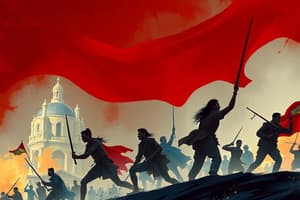Podcast
Questions and Answers
What event in 1872 significantly contributed to the rise of nationalism in the Philippines?
What event in 1872 significantly contributed to the rise of nationalism in the Philippines?
- The return of the Jesuits
- The establishment of Spanish haciendas
- The death of secular priests
- The execution of three priests (correct)
What fueled the conflict between regular priests and secular priests in the Philippines?
What fueled the conflict between regular priests and secular priests in the Philippines?
- Differences in cultural practices
- Territorial disputes over Mindanao
- Support from the Spanish government (correct)
- The expulsion of Jesuits
Who were considered the regular priests in the context provided?
Who were considered the regular priests in the context provided?
- Clergy from Maguindanao
- Secular priests of mestizo descent
- Those serving local Filipino communities
- Members of religious orders like Jesuits and Agustinians (correct)
What was a direct consequence of the intrachurch strife mentioned?
What was a direct consequence of the intrachurch strife mentioned?
What was a key characteristic of secular priests according to the content?
What was a key characteristic of secular priests according to the content?
Which group primarily reclaimed parishes in Mindanao after returning from expulsion?
Which group primarily reclaimed parishes in Mindanao after returning from expulsion?
What did the Spanish government's support for regular priests lead to in terms of priestly roles?
What did the Spanish government's support for regular priests lead to in terms of priestly roles?
In what way did secular priests respond to the pressure they faced?
In what way did secular priests respond to the pressure they faced?
Who took over the leadership after Father Pedro Pelaez's death?
Who took over the leadership after Father Pedro Pelaez's death?
What was significant about the actions of the Filipinos during the Cavite mutiny?
What was significant about the actions of the Filipinos during the Cavite mutiny?
Which of the following events directly contributed to the expulsion of the Jesuits in 1768?
Which of the following events directly contributed to the expulsion of the Jesuits in 1768?
What was the eventual fate of Fathers Burgos, Gomez, and Zamora?
What was the eventual fate of Fathers Burgos, Gomez, and Zamora?
What was a significant outcome of the Cavitenyos' strike?
What was a significant outcome of the Cavitenyos' strike?
Which figure was able to decrease his sentence despite being involved in the strike?
Which figure was able to decrease his sentence despite being involved in the strike?
What ultimately caused the failure of the uprising in Cavite?
What ultimately caused the failure of the uprising in Cavite?
What was the initial intention behind the actions of the Filipino clergy during this period?
What was the initial intention behind the actions of the Filipino clergy during this period?
Flashcards are hidden until you start studying
Study Notes
The Cavite Mutiny
- The Cavite Mutiny was a strike by Filipino soldiers in 1872 against the Spanish government in response to issues involving Filipino secular priests.
- The mutiny was sparked by the dismissal of workers at the Cavite arsenal and the removal of their tax exemptions.
- The mutiny failed due to the defection of Filipino troops and the execution of key leaders, including Father Jose Burgos, Father Mariano Gomez, and Father Jacinto Zamora.
Secular vs. Regular Priests
- The conflict between secular and regular priests in the Philippines stemmed from the power dynamics, the Spanish government's support for regular priests, and the re-entry of Jesuit priests in 1859.
- Regular priests were from religious orders like San Agustin, Jesuits, and Recoletos.
- Secular priests were Filipino priests of mixed-race backgrounds, including mestizos, "indios," and creoles.
- Secular priests, including Father Pedro Pelaez, were denied positions and parishes.
- The conflict intensified because of the "intrachurch strife," a struggle for power and authority, which ignited nationalism among Filipinos seeking independence.
The Role of Father Pedro Pelaez
- Father Pelaez was a Spaniard born in the Philippines appointed Vicar Capitular of Manila after Archbishop Jose Aranguren's death in 1861.
- He championed the cause of Filipino clergy and supported their rights.
- His death in 1861 during the Manila Cathedral earthquake furthered the struggle for Filipino clergy.
The Execution of the Three Priests
- Father Jose Burgos, a protégé of Pelaez, emerged as a leader.
- The execution of Burgos, Gomez, and Zamora, known as the "Gomburza," fueled Filipino nationalism and resistance.
- They were falsely accused of leading the Cavite mutiny and executed on February 17, 1872.
The Legacy of the Cavite Mutiny
- The mutiny exposed the friars' role in fueling dissent against Spanish rule.
- It was a catalyst for the rise of Filipino nationalism and the emergence of intellectual leaders like Jose Rizal, Marcelo H. del Pilar, and Graciano Lopez Jaena.
- The mutiny served as a stepping stone toward the Philippine Revolution in 1896.
Studying That Suits You
Use AI to generate personalized quizzes and flashcards to suit your learning preferences.




